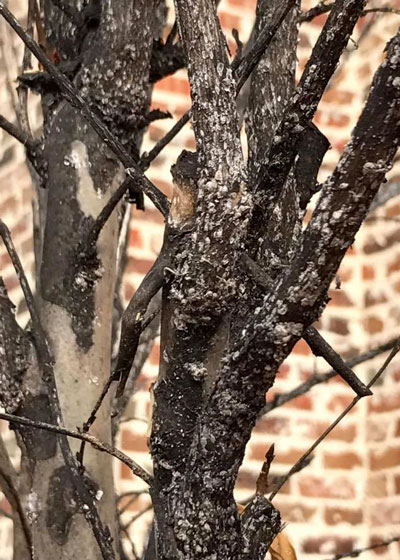Question of the Week: March 23, 2017

“Neil, what caused this black mold on my crape myrtle, and how can I eliminate it?”
The black mold you see is referred to by plant pathologists as sooty mold (for obvious reasons). However, it’s essentially cosmetic – ugly as can be, but not especially harmful. However, nobody wants to have it around.
Aphids sometimes camp out on crape myrtle foliage in mid-summer. As they feed, they exude sticky honeydew residue onto the plant and other surfaces below. Other species of aphids will do the same thing to elms, pecans, oaks and other shade trees. So will lace bugs.
However, in this particular case, this sooty mold is growing in the honeydew residue from crape myrtle bark scale insects. This is a new species of scale that was first observed in the United States in Richardson, Texas, in 2004. For many years it was pretty much isolated to the northern half of Dallas County and southern Collin County, but in the past several years it has spread eastward across the United States. If you are an e-gardens reader in Southwest or West Texas, odds are that you haven’t yet seen it.
Because we have thousands of crape myrtles planted in McKinney as a part of our Crape Myrtle Trails of McKinney project, we have taken great interest in this pest. Here are things we believe to be fact:
• This pest is worse some years than others. 2007 was the only really bad year across large numbers of plants, due perhaps to the exceptionally rainy June that year.
• Crape myrtle bark scale was originally thought to be a variety of azalea bark scale, but it has subsequently been found to be a species native to Asia that somehow made its way to the United States.
• Some crape myrtle varieties appear to be more prone to this pest than others, but researchers are not sure if this is genetic or perhaps more a factor of local growing conditions. More research is underway.
• This pest does not kill the crape myrtles. In fact, crape myrtles almost never die from it. But it appears to stress the tree and may reduce blooming. And the honeydew and black sooty mold certainly reduce the attractiveness of the tree.
• The good news is that a soil drench at the base of the tree using one of the systemic insecticides imidacloprid or dinotefuran provides good season-long protection. Applications can be made any time during the summer beginning with leaf emergence in the spring.
• Left untreated, a large percentage of the outbreaks are eventually brought under control by a predatory ladybug – black with two bright orange spots on its back, hence the name “twice-stabbed ladybug.” Immature nymphs of the ladybugs do not resemble the adults at all, so look closely before you start treating. In the absence of the ladybugs, or when the ladybugs fail to prevent honeydew and sooty mold, you will probably want to apply the systemic insecticide drench.
• Crape myrtles shed all of their old bark every 12 to 18 months. As they do, all of the sooty mold will fall to the ground. You can see that this has happened to part of the stems in the photo.
With special thanks to Dr. Mike Merchant, Entomologist Texas AgriLife Extension for his research and input into our understanding of this pest.
